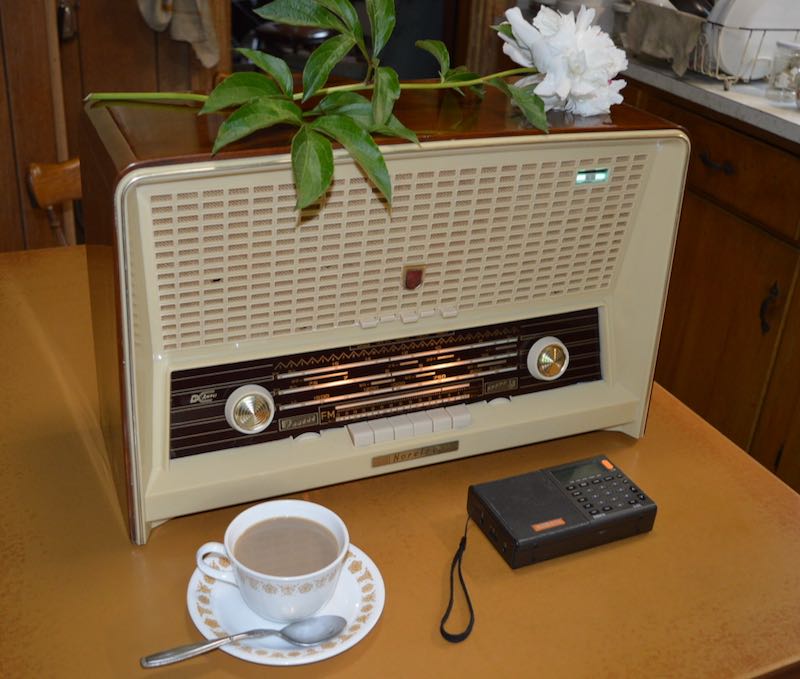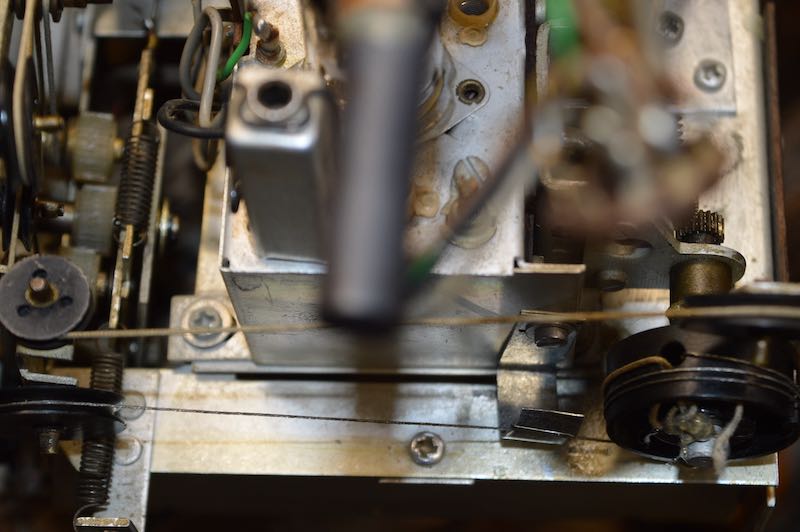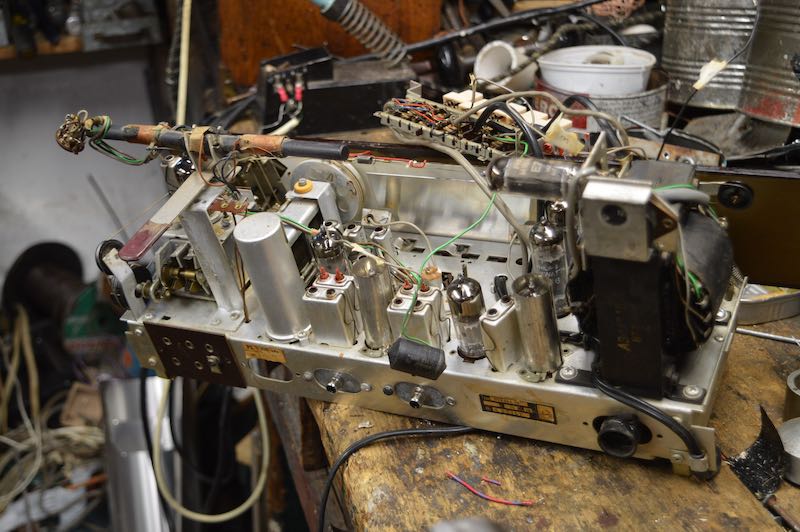Many thanks to SWLing Post contributor, Edward Ganshirt, who shares the following guest post:
 Pamela’s radio
Pamela’s radio
A neighbor gave me this radio. It had a story.
It is a Norelco B5X-88A/03 Table radio AM FM SW1 SW2. (You can see it takes up the whole kitchen table…that is why it is called a table radio). Has very good sound.
The speakers are 600 ohms, not 8 ohms, and uses bypass capacitors instead of an audio transformer.
Now about the carnation: I think my neighbor had thoughts that I may be giving it a Funeral and interring it in the backyard. (It has a nice finish you usually see on caskets)
Her Father was a Doctor who had his practice in the house and had this radio always playing low volume in the waiting room. He served in WW2 and brought this back in the late 1940’e. She inherited it and had it serviced a few times by a local repairman who since passed. Taking it apart I noticed several mechanical problems after removing an abandoned yellow jacket’’ nest.
The FM dial string was wound wrong so 88 MHz is where 108 MHz should be and vice versa. I restrung the dial properly but when tuned the string flopped off the pulley, so I fabricated a string restrainer to prevent this.
Also the station selector was scratchy and intermittent. To solve this, I played the garden hose with a forceful stream of water on the switches then dried out the chassis in the hot summer sun. Sprayed volume control restorer on all the switch contacts. After that, it worked perfectly. The remaining issue was the walnut veneer I sanded with 400 grit paper then coated with clear Krylon .
Now what to do with it!
Well I used her same sweet talk charm she used on me to take it off her hands to take it back, this time fully functional and I even demo-ed it. It had the wonderful mellow sound that she remembered and was so pleased.
What a true gentleman you are, Ed! Thank you for sharing the story of this Norelco table radio–what a gorgeous machine! I’m so pleased you were able to surprise Pamela with her father’s radio, fully restored!



My dad had a very similar looking radio at his store for decades. It went on and on, running 24/7 until the roof leaked directly on it one night and that was it. It was there for over 50 years, and I remember when it replaced an awful looking green Zenith radio that didn’t last too long before having a solder joint go bad. The Zenith came home and sat for a few years until I was about 10 and found it in a cupboard and found if I smacked it, it worked. A few minutes of poking a mold tree from a model car kit found the cracked joint and soon it was working fine.
Great radio! That is a white peony on top of the radio. I am a gardener, I should know! About 2 years ago I bought a wonderful old Grundig model RTV 320U, build in Germany in 1969. I set it up in the kitchen, once home and arbitrarily wired it with a speaker and rudimentary antenna to see if and how it works. I was impressed! I then took it apart and cleaned it up, sanded and re-varnished the teak cabinet. The radio has 2 tuning dials, one for AM and SW, and the top dial for FM, the high numbers on the left and low on the right.
Very Nice Radio! I’m sure your friend was really excited to receive it back sounding so good!!!
A nice story about a couple good neighbors and a beautiful old radio. Thank you!
Many years ago, as a young teen, I recall my parents renting an apartment with one of these Table Radios in it. It was this exact model. And yes, someone had been in there at some time in the past and wired the dial backwards. It was like that for AM Broadcast. There wasn’t much FM broadcast to listen to at the time.
I remember this because I was terribly confused trying to tune in the various stations I thought should be there, until a neighbor helped us out by showing me that the dial was not rigged correctly.
Unfortunately for this young radio enthusiast, it was also deaf as could be on shortwave.
“The FM dial string was wound wrong so 88 MHz is where 108 MHz should be and vice versa.”
It’s a bit hard to see from the pics, but it looks like it might have been correct originally – it was pretty common for Philips (& other European brand) radios of that era to have the FM dial ‘backwards’, with 87.5 on the right and 100/104/108 on the left.
If the dial string was meant to run from higher frequencies on the left to lower frequencies on the right, the markings on the dial would have been that way too. I guess the person who restored the radio corrected it so it would match the markings on the dial.
BTW: this is a late 1950s model, definitely not 1940s.
They had it strung wrong. I first made a chart of dial settings vs station received and discovered it was backwards. The drum would roll correctly with the string. Restringing it made the frequency received consistent with the dial markings. This was confounding as being done right the string would roll off the roller which required me to fabricate a sheet-metal guard bar to prevent this. If all the radios of the manufacturing line were built wrong, what was the QC department smoking?